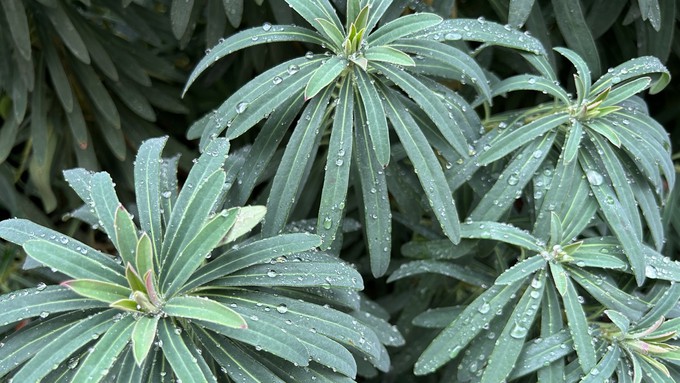
Watch out for leaning trees and cracked soil

Raindrops dot this euphorbia plant after Wednesday morning's storm. The Sacramento region received varying amounts of rainfall this week. Kathy Morrison
How much rain did you get? Chances are – a lot!
Sacramento’s first atmospheric river of the 2023-24 rainy season gave our region a good, deep soaking. Starting Sunday night through Tuesday midnight, Downtown Sacramento recorded 2.61 inches, according to the National Weather Service. That includes a record 1.6 inches on Tuesday, Dec. 19.
Other parts of the greater Sacramento area received more – or less. Here in the Pocket/Greenhaven neighborhood, my rain gauge collected just under 4 inches. That includes some showers from Wednesday morning.
Meanwhile, Davis recorded only 1.24 inches since Sunday, says the weather service.
Rain totals from the thunderstorms that blew across our region Tuesday afternoon illustrate the hit-or-miss tendency of this storm system. Sacramento Executive Airport recorded 1.55 inches in the 24-hour period of 4 a.m. Tuesday-Wednesday, according to the California Nevada River Forecast Center, a part of the National Oceanic and Atmospheric Administration. For that same period, Elk Grove received only 0.16 inches.
Also for that same 24 hours, Sacramento State’s rain gauge recorded 1.06 inches while the gauge at Arcade Creek-Winding Way in Carmichael received only 0.39.
While much of Sacramento was getting drenched Tuesday, Roseville, Fair Oaks, Rocklin, Orangevale, Lincoln and Rancho Cordova all recorded less than one-third inch.
A lot of rain in a hurry not only leads to possible flooding; it can destabilize trees – especially if followed by strong gusts of wind.
After the rain stops, take a look around your landscape. If you notice a tree leaning or cracks in the lawn or soil around a tree or large shrub, call an arborist. Those cracks are caused by roots being pulled out of place. You may need expert help to keep that tree upright.
Also be careful walking on wet soil; it can compact easily, squeezing out the vital air pockets needed by roots and microorganisms.
For more on Sacramento weather: https://www.weather.gov/sto/#.
Comments
0 comments have been posted.Sacramento Digs Gardening to your inbox.
Food in My Back Yard Series
May 6: Maintain soil moisture with mulch for garden success
April 29: What's (already) wrong with my tomato plants?
April 22: Should you stock up on fertilizer? (Yes!)
April 15: Grow culinary herbs in containers
April 8: When to plant summer vegetables
April 1: Don't be fooled by these garden myths
March 25: Fertilizer tips: How to 'feed' your vegetables for healthy growth
March 18: Time to give vegetable seedlings some more space
March 11: Ways to win the fight against weeds
March 4: Potatoes from the garden
Feb. 25: Plant a fruit tree now -- for later
Feb. 18: How to squeeze more food into less space
Feb. 11: When to plant? Consider staggering your transplants
Feb. 4: Starting in seed starting
Sites We Like
Garden Checklist for week of May 11
Make the most of the lower temperatures early in the week. We’ll be back in the 80s by Thursday.
* Plant, plant, plant! It’s prime planting season in the Sacramento area. Time to set out those tomato transplants along with peppers and eggplants. Pinch off any flowers on new transplants to make them concentrate on establishing roots instead of setting premature fruit.
* Direct-seed melons, cucumbers, summer squash, corn, radishes, pumpkins and annual herbs such as basil.
* Harvest cabbage, lettuce, peas and green onions.
* In the flower garden, direct-seed sunflowers, cosmos, salvia, zinnias, marigolds, celosia and asters. (You also can transplant seedlings for many of the same flowers.)
* Plant dahlia tubers.
* Transplant petunias, marigolds and perennial flowers such as astilbe, columbine, coneflowers, coreopsis, dahlias, rudbeckia and verbena.
* Keep an eye out for slugs, snails, earwigs and aphids that want to dine on tender new growth.
* Feed summer bloomers with a balanced fertilizer.
* For continued bloom, cut off spent flowers on roses as well as other flowering plants.
* Add mulch to the garden to maintain moisture. Mulch also cuts down on weeds. But don’t let it mound around the stems or trunks of trees or shrubs. Leave about a 6-inch-to-1-foot circle to avoid crown rot or other problems.
* Remember to weed! Pull those nasties before they set seed.
* Water early in the day and keep seedlings evenly moist.